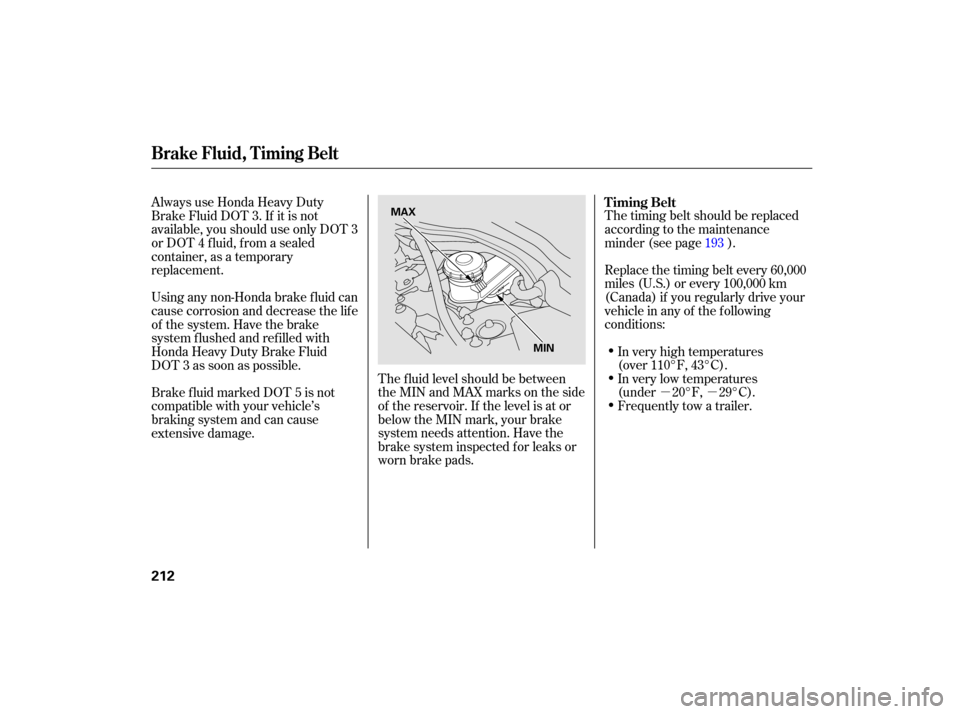Page 189 of 287

To achieve a proper tongue load,
start by loading 60 % of the load
toward the front of the trailer and
40 % toward the rear, then re-adjust
the load as needed.The total weight of the vehicle, all
occupants, all cargo, and the
tongue load must not exceed: The total weight of each axle must
not exceed:
The best way to conf irm that vehicle
and trailer weights are within limits
is to have them checked at a public
scale. To locate the public scales in
your area, consult your local yellow
pages or ask your dealer f or
assistance.
Using a suitable scale or a special
tongue load gauge, check the tongue
load the f irst time you set up a
towing combination (a f ully-loaded
vehicle and trailer), then recheck the
tongue load whenever the conditions
change.
on the f ront axle
on the rear axle
Checking L oads
Gross Vehicle Weight Rating
(GVWR): Gross Axle Weight Rating
(GA WR):
Towing a Trailer
186
4,564 lbs (2,070 kg)2,469 lbs (1,120 kg)
2,138 lbs (970 kg)
06/08/08 14:46:37 31SDR620_191
Page 190 of 287

Honda recommends that any trailer
having a total weight of 1,000 lbs
(450 kg) or more be equipped with
its own electric or surge-type brakes.
If you choose electric brakes, be
sure they are electronically actuated.
Do not attempt to tap into your
vehicle’s hydraulic system. No
matter how successf ul it may seem,
any attempt to attach trailer brakes
to your vehicle’s hydraulic system
will lower braking ef f ectiveness and
create a potential hazard.
See your trailer dealer or rental
agency f or more inf ormation on
installing electric brakes.
Any hitch used on your vehicle must
be properly bolted to the underbody.
Always use saf ety chains when you
tow a trailer. Make sure the chains
are secured to the trailer and hitch,
and that they cross under the tongue
and can catch the trailer if it
becomes unhitched. Leave enough
slack to allow the trailer to turn
corners easily, but do not let the
chains drag on the ground.
Towing can require a variety of
equipment, depending on the size of
your trailer, how it will be used, how
much load you are towing, and
where you tow. To ensure the best
quality, we recommend that you
purchase Honda equipment
whenever possible.
Discuss your needs with your trailer
sales or rental agency, and f ollow the
guidelines in the rest of this section.
Also make sure that all equipment is
properly installed and that it meets
f ederal, state, province, and local
regulations. T owing Equipment and
A ccessories
Trailer Brakes
Hitches
Saf et y Chains
Towing a Trailer
Driving
187
06/08/08 14:46:47 31SDR620_192
Page 191 of 287
Ask your trailer sales or rental
agency if any other items are
recommended or required f or your
towing situation.
Since lighting and wiring vary by
trailer type and brand, you should
have a qualif ied technician install a
suitable connector between the
vehicle and the trailer. Improper
equipment or installation can cause
damage to your vehicle’s electrical
system and af f ect your vehicle
warranty. Trailer lights and equipment must
comply with f ederal and state
regulations. Check with your trailer
sales or rental agency f or the
requirements in your area, and use
only equipment designed f or your
vehicle. Many states and provinces require
special outside mirrors when towing
a trailer. Even if they don’t, you
should install special mirrors if you
cannot clearly see behind you, or if
the trailer creates a blind spot.T railer L ight s
A ddit ional T owing Equipment
Towing a Trailer
188
06/08/08 14:46:54 31SDR620_193
Page 192 of 287

When preparing to tow, and bef ore
driving away, be sure to check the
f ollowing:The vehicle has been properly
serviced, and the tires, brakes,
suspension, cooling system, and
lights are in good operating
condition.
The lights and brakes on your
vehicle and the trailer are working
properly. All items in or on the trailer are
properly secured and cannot shif t
while you drive. Thehitch,safetychains,andany
other attachments are secure. All weights and loads are within
limits (see pages and ). Your vehicle tires and spare are
properly inf lated (see page ),
and the trailer tires and spare are
inflated as recommended by the
trailer maker.
Foryoursafetyandthesafetyof
others,taketimetopracticedriving
maneuvers bef ore heading f or the
open road, and f ollow the guidelines
below. The added weight, length, and
height of a trailer will af f ect your
vehicle’s handling and perf ormance,
so driving with a trailer requires
some special driving skills and
techniques. Driveslowerthannormalinall
driving situations, and obey posted
speed limits f or vehicles with trailers.
UsetheDpositionwhentowinga
trailer on level roads. Do not exceed
55 mph (88 km/h). At higher speeds,
thetrailermayswayoraffectvehicle
handling.
D is the proper shif t lever position
tousewhentowingatrailerinhilly
terrain.
185 186 224
3
Pre-T ow Checklist
Driving Saf ely With a T railerT owing Speeds and Gears
Towing a Trailer
Driving
189
06/08/08 14:47:07 31SDR620_194
Page 193 of 287

Maketurnsmoreslowlyandwider
than normal. The trailer tracks a
smaller arc than your vehicle, and it
canhitorrunoversomethingthe
vehicle misses. Allow more time and
distance f or braking. Do not brake or
turn suddenly as this could cause the
trailer to jackknif e or turn over.
When climbing hills, closely watch
your temperature gauge. If it nears
the red (Hot) mark, turn the air
conditioning of f , reduce speed and, if
necessary, pull to the side of the
road to let the engine cool.Always drive slowly and have
someone guide you when backing up.
Grip the of the steering
wheel; then turn the wheel to the lef t
to get the trailer to move to the left,
andturnthewheelrighttomovethe
trailer to the right.
Follow all normal precautions when
parking, including f irmly setting the
parking brake and putting the
transmission in Park. Also, place
wheel chocks at each of the trailer’s
tires.
Crosswinds and air turbulence
caused by passing trucks can disrupt
your steering and cause the trailer to
sway. When being passed by a large
vehicle, keep a constant speed, and
steer straight ahead. Do not try to
make quick steering or braking
corrections. When driving down hills, reduce
your speed, and shif t down to second
gear. Do not ‘‘ride’’ the brakes, and
remember, it will take longer to slow
downandstopwhentowingatrailer.
If you must stop when f acing uphill,
use the f oot brake or parking brake.
Do not try to hold the vehicle in
placebypressingontheaccelerator,
as this can cause the automatic
transmission to overheat.
bottom
Making T urns and Braking
Driving on Hills Handling Crosswinds and Buf f et ingBacking Up
Parking
Towing a Trailer
190
06/08/08 14:47:17 31SDR620_195
Page 202 of 287

�Î
�Î
�Ì �Ì
�µ
�µ
�Ì
�Î
Maintenance Minder
199
Maintenance Main Items
Replace engine oil
Replace engine oil and oil filter
Inspect front and rear brakes
Check parking brake adjustment
Inspect these items: Tie rod ends, steering gear box, and boots
Suspension components
Driveshaft boots
Brake hoses and lines (including ABS)
All fluid levels and condition of fluids
Exhaust system
Fuel lines and connections Maintenance Sub Items
Rotate tires
Replace air cleaner element
Replace dust and pollen filter
Inspect drive belt
Replace transmission fluid
Replace spark plugs
Replace timing belt and inspect water pump
(V6 engine only)
Inspect valve clearance
Replace engine coolant
:
A
B
Symbol
1
2
3
4
5
Symbol1
1
See information on maintenance and emissions warranty in the first column
on page .
Inspect idle speed every 160,000 miles (256,000 km).
If the message ‘‘SERVICE’’ does not appear more than 12 months after the
display is reset, change the engine oil every year.
Independent of the maintenance messages in the information display,
replace the brake fluid every 3 years.
Adjust the valves during services A, B, 1, 2, or 3 only if they are noisy.
NOTE: 1:
198
If you drive in dusty conditions, replace every 15,000
miles (24,000 km).
If you drive primarily in urban areas that have high
concentrations of soot in the air from industry and from
diesel-powered vehicles, replace every 15,000 miles
(24,000 km).
Driving in mountainous areas at very low vehicle speeds
or trailer towing results in higher transmission and
transfer temperatures. This requires transmission and
transfer fluid changes more frequently than
recommended by the Maintenance Minder. If you
regularly drive your vehicle under these conditions, have
the transmission and transfer fluid changed at 60,000
miles (100,000 km), then every 30,000 miles (48,000 km).
If you drive regularly in very high temperatures (over
110°F, 43°C), or in very low temperatures (under 20°F,29°C), replace every 60,000 miles (U.S.)/100,000 km
(Canada).
Maintenance Minder
06/08/08 14:48:43 31SDR620_204
Page 215 of 287

�µ�µ
The timing belt should be replaced
according to the maintenance
minder (see page ).
Replace the timing belt every 60,000
miles (U.S.) or every 100,000 km
(Canada) if you regularly drive your
vehicleinanyof thefollowing
conditions:
In very high temperatures
(over 110°F, 43°C).
In very low temperatures
(under 20°F, 29°C).
Frequently tow a trailer.
The f luid level should be between
theMINandMAXmarksontheside
of the reservoir. If the level is at or
below the MIN mark, your brake
system needs attention. Have the
brake system inspected f or leaks or
worn brake pads.
Always use Honda Heavy Duty
Brake Fluid DOT 3. If it is not
available, you should use only DOT 3
or DOT 4 f luid, f rom a sealed
container, as a temporary
replacement.
Using any non-Honda brake f luid can
cause corrosion and decrease the lif e
of the system. Have the brake
system f lushed and ref illed with
Honda Heavy Duty Brake Fluid
DOT 3 as soon as possible.
Brake f luid marked DOT 5 is not
compatible with your vehicle’s
braking system and can cause
extensive damage.
193
Timing Belt
Brake Fluid, Timing Belt
212
MAX
MIN
06/08/08 14:50:34 31SDR620_217
Page 216 of 287
Your vehicle has two bulbs on each
side, f our in total. Make sure you are
replacing the bulb that is burned out.
Your vehicle uses halogen headlight
bulbs. When replacing a bulb, handle
it by its plastic case and protect the
glass from contact with your skin or
hard objects. If you touch the glass,
clean it with denatured alcohol and a
clean cloth.
Theheadlightswereproperlyaimed
when your vehicle was new. If you
regularly carry heavy items in the
trunk or pull a trailer, readjustment
may be required. Adjustments
should be perf ormed by your dealer
or other qualif ied mechanic. Headlight A iming Replacing a Headlight Bulb
Lights
Maint enance
213
Halogen headlight bulbs get very hot
when lit. Oil, perspiration, or a scratch
on the glass can cause the bulb to
overheat and shatter.
06/08/08 14:50:40 31SDR620_218